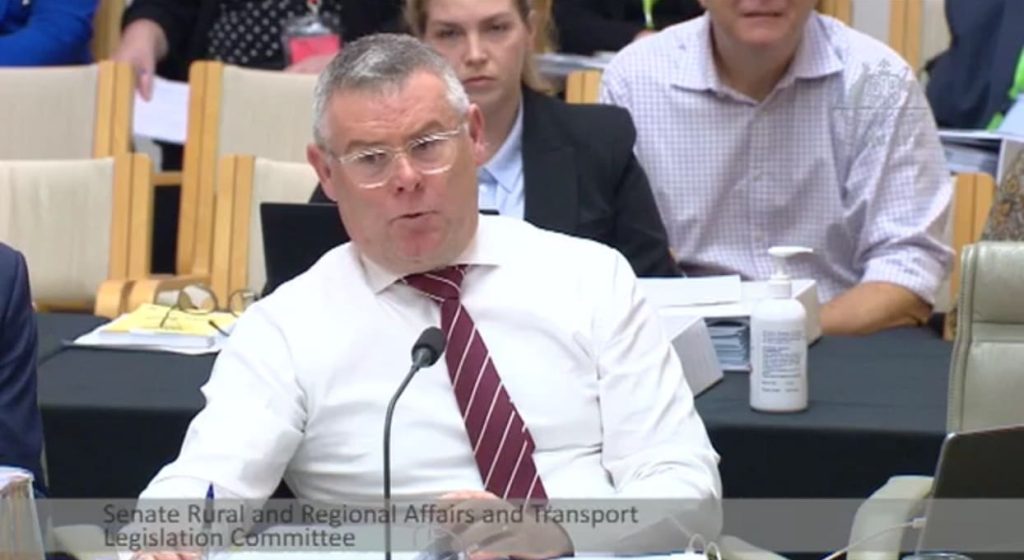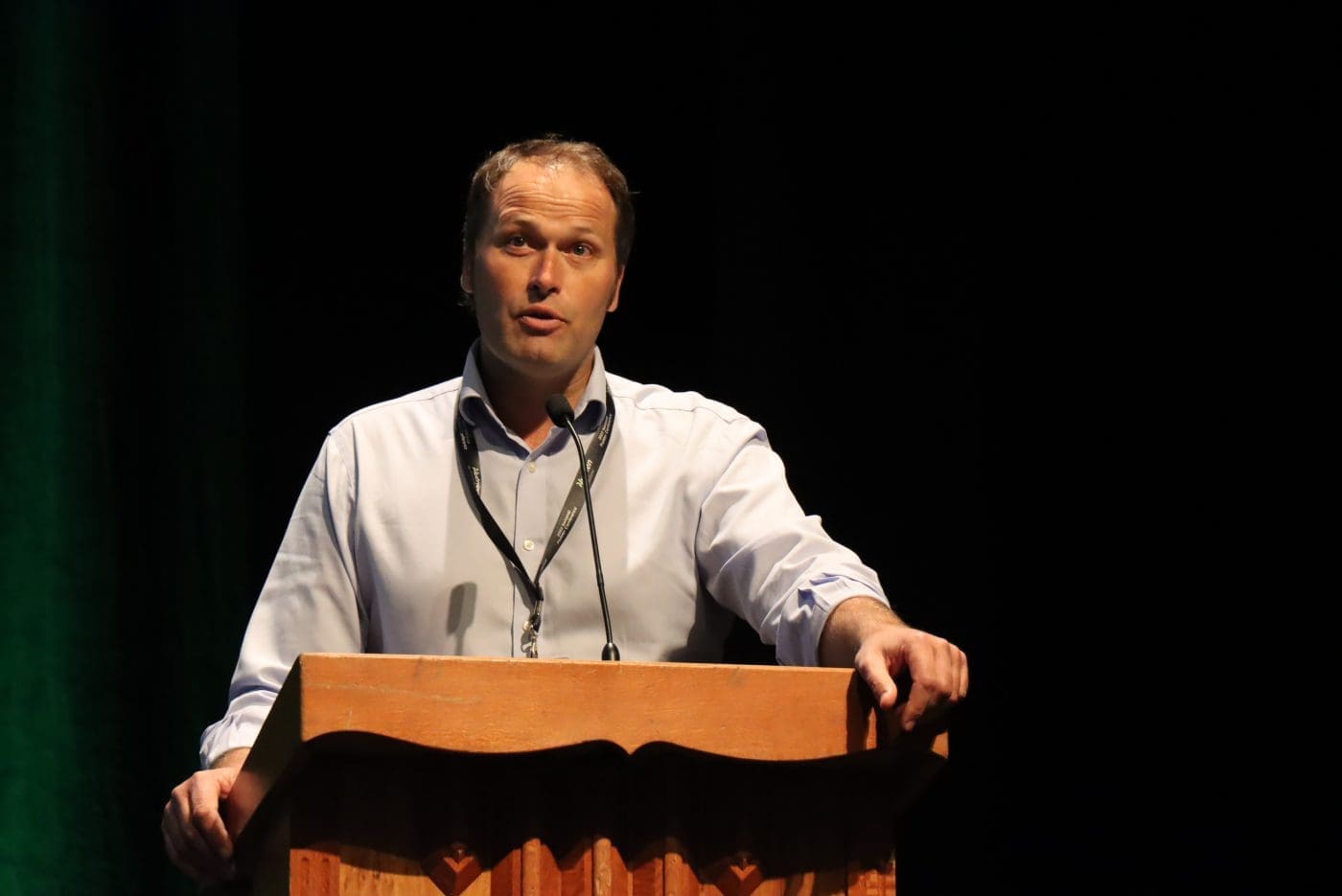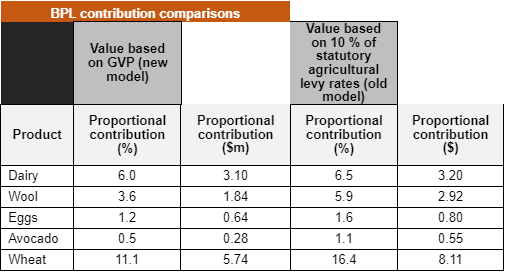
Minister for Agriculture Fisheries and Forestry Murray Watt at Senate Estimates today.
AGRICULTURAL commodity contributions to a proposed biosecurity protection levy have been cut by more than 30 percent under a new model announced by the Minister for Agriculture Fisheries and Forestry Murray Watt today.
In his opening statement at a Senate Estimates hearing Mr Watt said the biosecurity protection levy will contribute just six percent of the total biosecurity funding model, or about $50 million.
He said his department has undertaken extensive consultation over the back half of last year including stakeholder meetings, a survey of industry as well as inviting submissions to be made.
“We’ve listened to that feedback and as a result, today I’m announcing that we’re changing the way the biosecurity protection levy is calculated to make it fairer and more transparent,” he said.
 Mr Watt said the key feedback from industry on the proposed design included concerns about; the equity and fairness of levy rates across different commodities; association and confusion with the existing agricultural levies system; and multiple imposition points for some commodities across the supply chain.
Mr Watt said the key feedback from industry on the proposed design included concerns about; the equity and fairness of levy rates across different commodities; association and confusion with the existing agricultural levies system; and multiple imposition points for some commodities across the supply chain.
“Changes to the design of the levy have taken these issues into account.
“Rates will be set using a common and equitable basis for all industry sector products and goods and will not be set by reference to 2020-21 agricultural levy rates, as was originally proposed,” Mr Watt said.
“In addition, imposition of the levy will be tailored to individual products and goods to reduce multiple imposition points across a product’s supply chain.”
Cattle Australia pleased with changes
Cattle Australia chief executive officer Dr Chris Parker said the minister had listened to grass-fed cattle producers, and the broader agriculture sector, and he appreciated his willingness to take on board some of industry’s serious concerns with the BPL.
“While our preference is that the Government capture all sectors in any levy arrangements, the grass-fed cattle industry appreciates now having a seat at the table in discussions surrounding the development and implementation of the levy, and the opportunity to work with Government to further understand the details of the amended BPL design,” Dr Parker said.
“We believe the BPL in its current form does not share the cost of biosecurity with all sectors of the economy, and maintain our position that a detailed analysis of who the beneficiaries and risk creators are will be required to achieve a truly equitable policy.
“As part of forthcoming discussions, we will seek more details about the design, implementation and oversight of the BPL.
“Without appropriate implementation, co-design planning, stakeholder oversight and adequate safeguards, the BPL will be just another tax that reduces the competitiveness of the grass-fed cattle industry – an industry that is essential to the Australian economy.”
Dr Parker said the grass-fed cattle industry fundamentally supports increased investment in biosecurity and was committed to working with Government to ensure such funding delivers maximum value and produces the essential outcomes needed by industry and the broader Australian community.
“The imposition of this levy must result in improved biosecurity outcomes as a result of enhanced funding and resourcing of measures for the next decade of biosecurity,” he said.
Dr Parker said it is imperative that Government take existing expenses into due consideration when quantifying a biosecurity levy rate, to ensure the collection of funds is equitable across all industries prior to applying an additional proposed biosecurity protection levy.
“CA propose that these investments be specifically accounted for to encapsulate total investments by commodities,” Dr Parker said.
“It is critical that the collection of funds is transparent and used appropriately to leverage a stronger biosecurity system.”
“Still a gaping hole in information”
National Farmers’ Federation president David Jochinke said plenty of questions about the biosecurity levy were still unanswered.
 “We acknowledge today’s comments by the Minister recognising the significant concerns of industry, including issues related to equitability and transparency,” Mr Jochinke said.
“We acknowledge today’s comments by the Minister recognising the significant concerns of industry, including issues related to equitability and transparency,” Mr Jochinke said.
“However we still await significant further information concerning the levy’s design, and what it will practically look like for producers on the ground.
“We also want to see details on the potential impact on the existing levies system; transparency about how the collected funds will actually deliver dedicated, additional and tangible biosecurity outcomes; formalised producer oversight mechanisms; and proper recognition of existing producer contributions to the broader biosecurity system.
“Australia’s 85,000 farmers, along with thousands of supply chain participants, are still faced with what appears a fundamentally flawed proposal to be implemented in less than five months.
“There is still a gaping hole in information and we call on the Government to keep listening to producers and put in a process to properly address their concerns. ”
NSW Farmers also seeking more detail
With the levy set to be implemented on July 1 this year, NSW Farmers policy director Ash Cooper warned now was the time for the Federal Government to take the advice of the agricultural sector on board before it was too late.
“We welcome the government’s talk of keeping our country safe from risks such as foot and mouth disease – but this is not the way to do it,” Mr Cooper said.
“A recent Senate committee report on agricultural levies heard our concerns around the levy, but now we need to see these concerns addressed and clarified in further changes to the biosecurity levy bill if it is going to proceed.
“We all need to work together if we’re going to develop a solution that will bolster our biosecurity and protect the prosperity of our industry for generations to come.”
How the levies work

The BPL was previously to be calculated based upon 10pc of existing agricultural levies paid by each industry.
Under the new model, for every 1pc of gross agricultural, fisheries and forestry production, an industry will contribute a total of $500,000 towards the biosecurity protection levy. This industry contribution will then be proportionately split between all producers in that industry.
A media statement from Mr Watt today outlined that that cattle industry, including live cattle exports, between 2019-20 and 2021-22, contributed around 18pc of the gross value of production for our agriculture, fisheries and forestry industries. Under the revised model, the sector will pay around 18pc of the total BPL, or around $9 million annually. This $9 million contribution will then be split proportionately between all producers in the cattle industry.
The wool industry was to be levied about 2.92 million under the 10pc model, but this has been cut by 37pc to $1.84 million under the new model.
The BPL model changes will ensure that sectors who previously would not have contributed to the levy because they do not collect levy payments, are now included in the contributions.
Under the new BPL model;
taxpayers will contribute around 44pc of total biosecurity funding, including an increase to the passenger movement charge;
importers will contribute about 48pc;
producers will contribute about 6pc; and
Australia Post will contribute about 2pc
Mr Watt said the biosecurity protection levy ensures that those who directly benefit from Australia’s strong biosecurity make a modest and direct contribution to ensure the biosecurity system is sustainably funded into the future.
“As a result of other changes that the Government has already introduced, both taxpayers and importers are already making a much larger direct contribution to biosecurity costs.
“Importers have already contributed almost $220 million towards biosecurity cost recovery, including $28 million more under the Albanese Government’s new model.”
- Further details on the consultation are available at the Department of Agriculture, Fisheries and Forestry website at agriculture.gov.au/biosecurity-funding.




HAVE YOUR SAY